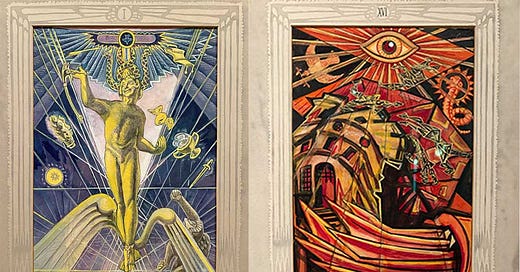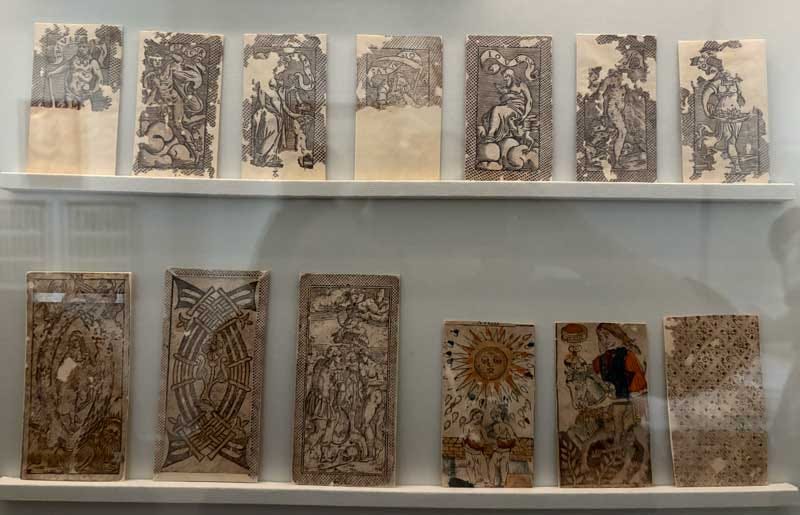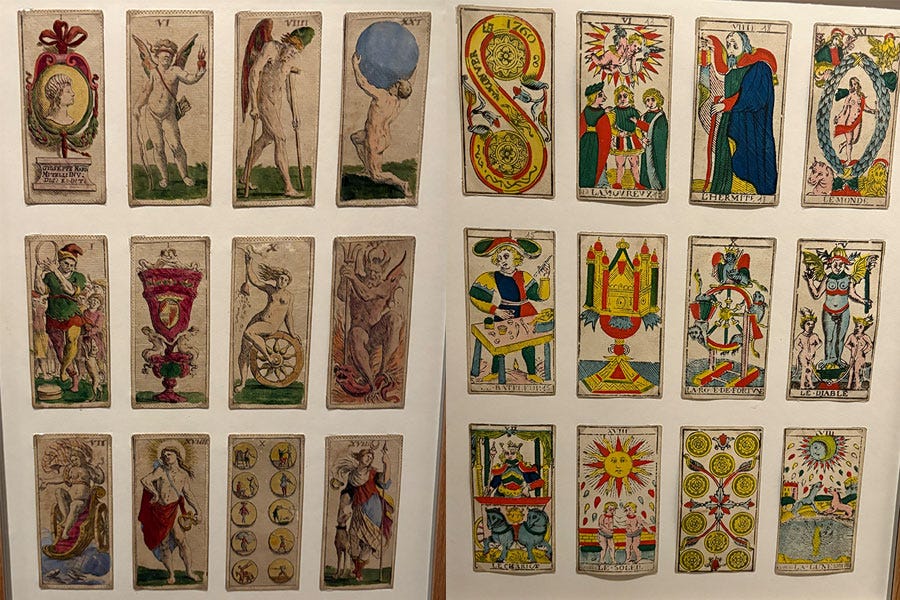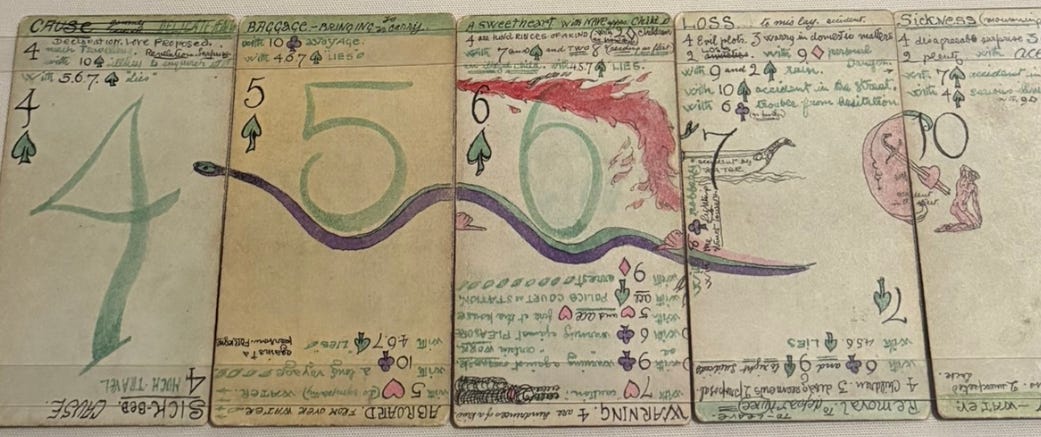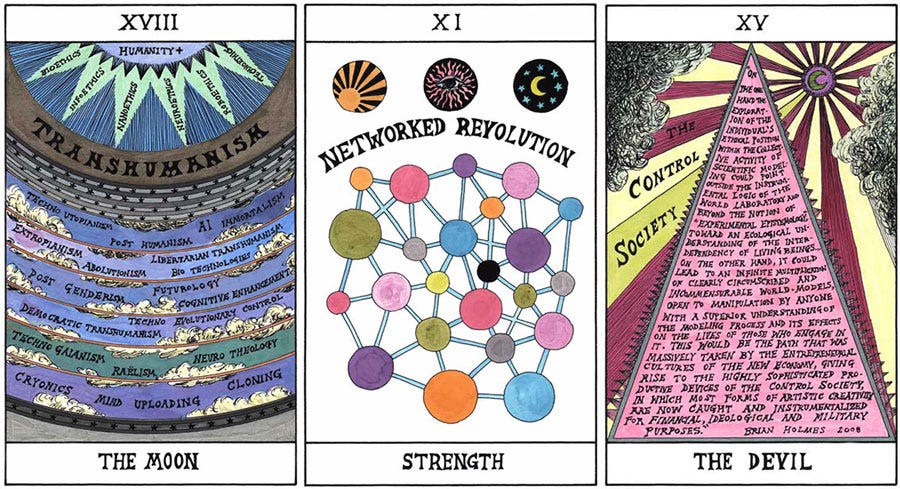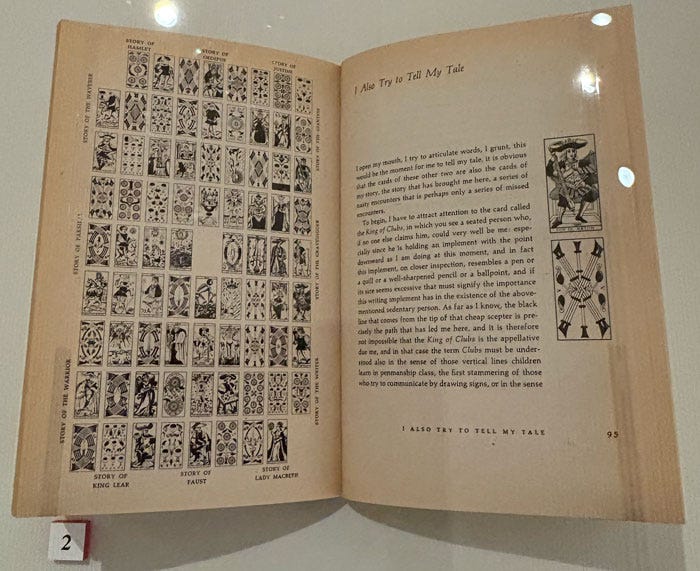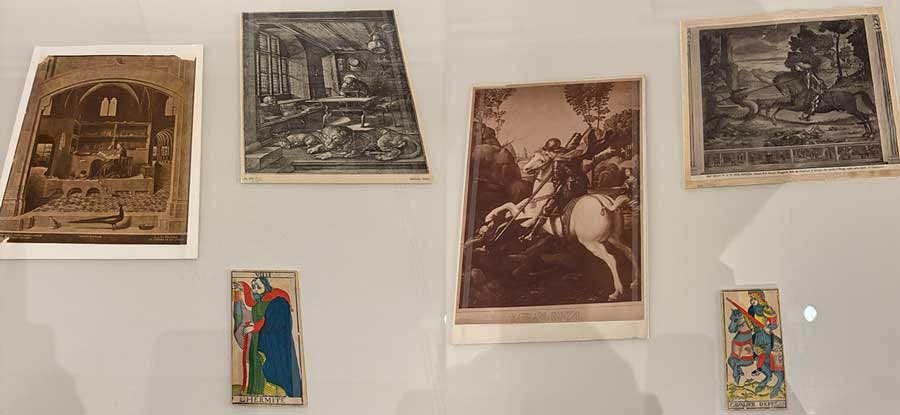TITAA #65.5: Motel of Crossed Destinies
Warburg Tarot & Calvino - Hopewell Geometry - 3D Cows - OLMoTrace - Fiction Context Benchmark - Weird Links

I have been on the road for 2 weeks and studying for a French exam for visa reasons, so this may be briefer than usual! (Update: maybe it isn’t.) Good thing it’s the weirdness issue, though.
TOC:
Intro piece: The Tarot Exhibit at the Warburg Institute in London
AI Creativity News (Briefly! No really. Video, 3D)
Weird and Esoteric News (Art, Folklore & Archaeology, Science, Tech)
The Tarot Exhibit at the Warburg Institute
I met up with friends to visit the Warburg Institute’s exhibit on Tarot cards a week ago. I’ve linked to the press about it in a few past issues (e.g., Guardian). Aby Warburg collected books on magic and the occult, and began collecting Tarot decks in 1902 as well. Warburg’s strange Image Atlas project contained a large section on Tarot art. The current exhibit features many beautiful and important classic works (including Pamela Colman Smith, Austin Osman Spare, Jean-Baptiste Alliette or “Etteilla,” Frieda Harris and Aleister Crowley…); as well as some historical mysteries, like how these cards from decks dated between the 15th and 18th centuries ended up in the sewers and water tanks of Milan’s Castle Forza:
Several very old decks were on display— on the right, a Tarot de Marseille deck (Nicolas Conver, c. 1860) and on the left, a rare Baroque style deck from Bologna, Tarocco Bolognese, by Mitelli (1634-1718), c. 1660, of which more below:
The artist reinterprets the tarot tradition according to the symbolism of his time. The suit of pentacles, for example, consists of different medals featuring Mitelli's favourite pastimes: painting, sculpting, music, dancing, hunting and fencing. In the trump cards, the Magician becomes a dancing street artist with his dogs; Love is depicted as Cupid; the Moon is Diana; the Sun is Apollo holding a cittern; and the World is depicted as Atlas holding the Earth.
Frieda Harris’s paintings for Aleister Crowley’s Thoth Tarot are at the Warburg and were on display. Wow, they are bright!
The Tarot work of Austin Spare was also on display—evidently Crowley rejected Spare from his magical organization in 1912 because: “An artist. Can’t understand organization or would have passed.” I’m into how these cards connect across the seams:
Suzanne Treister’s modern HEXEN 2 deck was also featured. Her decks (there is now a 5, in 2025) are techno-futurist and hopeful, combining history and science fiction in text-dense designs. From her site: “real histories are reconfigured stylistically into alchemical art forms in order to open up alternative ways of working with and thinking about the subjects.”
The section on Italo Calvino and his book The Castle of Crossed Destinies was particularly interesting to me as a fan of games and procedural narratives. He wrote to Frances Yates at the Warburg (yes, THAT one, Art of Memory etc), calling his novel an “iconology fiction.” In the book, travelers who pass through an enchanted wood can no longer communicate, except by using Tarot cards. From a display note at the exhibit:
In a 1967 lecture 'Cybernetics and Ghosts', Calvino had spoken of the pleasure derived from combinatorial play, and its power to generate meaning that 'the conscious mind would not have arrived at deliberately'. The Castle of Crossed Destinies (1969) was Calvino's first literary experiment with tarot cards. Its stories were prompted by the author's arrangement and rearrangement of cards from a 15th-century Visconti-Sforza tarot deck. In the spirit of the experimental writing collective Oulipo, of which he was a member, Calvino would later describe tarot as a 'combinatorial narrative machine'.
A spread from a copy of the book on display:
Intriguing to me — as one who works with museum imagery and semantic search! — the Warburg’s panel noting:
Calvino reflected on the idea that the 'trick' of producing stories from sequences of tarot cards could also be performed using artworks in museums. Using images drawn from Aby Warburg's Photographic Collection, we present here some of the specific artworks that Calvino describes and which he links to the iconography of The Hermit and The Knight of Swords.
The artworks for the Hermit (left) are “Photographs of Antonello da Messina, Saint Jerome in his Study, c. 1474; Albrecht Dürer, Saint Jerome in His Study, 1514” and for the Knight, “Raphael Sanzio, Saint George and the Dragon, c. 1506; Vittore Carpaccio, St. George and the Dragon, 1516.”
Technically, one could recreate Calvino’s idea by using a multimodal semantic search on aspects of a tarot card or spread, with museum artifacts as the search targets. It would be extremely easy to do this today, with a well-digitised, captioned, and indexed collection of assets.
Finally — most hilarious: “Calvino had planned to write a third group of stories titled 'The Motel of Crossed Destinies' prompted by popular comic strips rather than tarot cards. The project was never realised.” This Must Be Done. I recommend calling it The Oceanview Motel.
Preview for the sections below the paywall (please join us!): some important video model tool releases, monkeys writing Shakespeare, cows watching a video in a 3d world, a strange geometric archaeology site in Ohio, a long context fiction benchmark I didn’t know about, asking Claude what it wants to discuss, a model to train on dolphin squeaks and cow ear twitches, John Carmack on AI and games, a photography game that looks gorgeous, a good writeup of using AI tools to make a point-and-click visual CYOA game, some new multimodal embedding models, OLMoTrace to see how your output is biased by input text, and much more!

